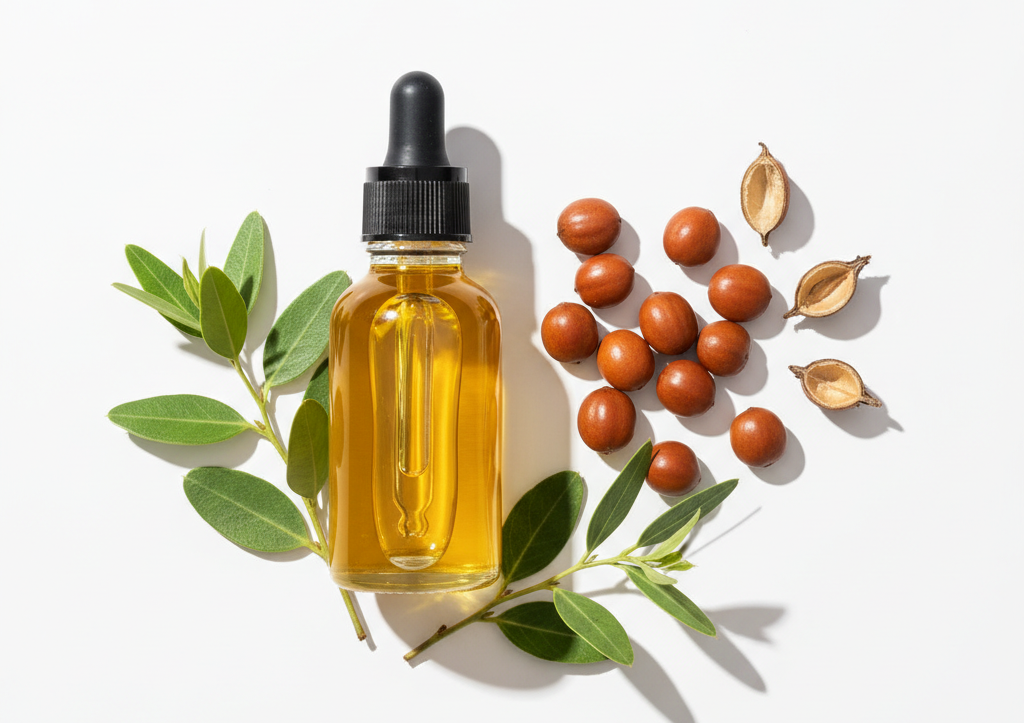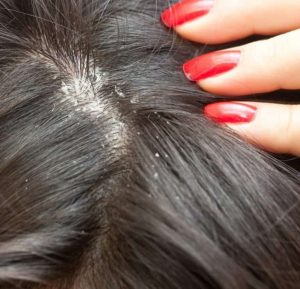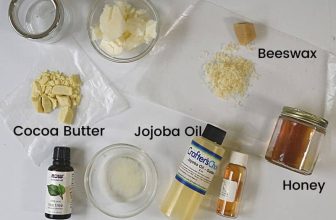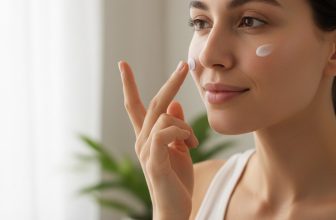
Seborrheic dermatitis is a frequent skin problem. It makes the skin red and flaky, usually on the scalp.
A lot of people look for natural ways to deal with this problem. One option that is getting a lot of attention is jojoba oil. The seeds of the jojoba plant make this oil. It is known for its nutrients that are good for the skin and its ability to moisturise. A lot of people say that jojoba oil makes their skin feel better.
It can aid with dryness and inflammation. This oil may also assist in keeping oil output in check. This balance can be quite useful for people who have seborrheic dermatitis. Knowing how jojoba oil can help your skin may help with symptoms and make your skin healthier.
Jojoba Oil for Seborrheic Dermatitis
Jojoba oil is a natural cure.
Many people use jojoba oil to take care of their skin. It is known for its soothing properties. Many people use it for seborrheic dermatitis. This condition causes red, flaky skin. Jojoba oil can help calm irritation. It also keeps the skin moist without blocking pores.
The Magic Of Jojoba
Oil extracted from jojoba plants is known as jojoba seed oil. The natural oil that our skin generates, known as sebum, is quite similar to this. This similarity helps the oil absorb easily. It also keeps the skin’s oil production in check.
This oil is rich in vitamins E and B. These vitamins nourish the skin and promote healing. Jojoba oil has anti-inflammatory properties. It reduces redness and swelling caused by dermatitis.
Why use natural oils?
Jojoba and other natural oils are good for your skin. There are no harsh chemicals in them. This makes them safe for sensitive skin. Using natural remedies can reduce irritation. They provide hydration without side effects.
Many people prefer natural solutions. They seek ways to care for their skin without synthetic ingredients. Jojoba oil is a great option. It offers both moisture and relief.
Seborrheic Dermatitis: An Overview
Seborrheic dermatitis is a common skin condition. It causes red, flaky, and itchy patches. This skin issue often appears on the scalp, face, and other oily areas. It can affect people of all ages. Stress, weather, and hormones can make it worse. Knowing what causes and triggers this illness can help you deal with it.
Signs and Causes
Different people have different symptoms. Redness and scaly areas are common indications. Itching and burning feelings are also common. Some people may find that their skin is oily or greasy. In very bad cases, it can flake.
Many factors can trigger seborrheic dermatitis. Stress often worsens symptoms. Weather changes can also play a role. Certain medications may irritate the skin. Skin conditions like psoriasis or eczema can increase the risk.
Current Treatments
Several treatments exist for seborrheic dermatitis. Over-the-counter shampoos can help. Look for ingredients like ketoconazole or salicylic acid. These can help with flaking and swelling.
Creams and lotions that you put on your skin work too. They may contain corticosteroids or antifungal agents. Prescription options are available for severe cases. Lifestyle changes can improve skin health. Regular washing and moisturizing are key. Avoid harsh soaps and irritants to keep skin calm.
The Science Behind Jojoba Oil
Jojoba oil is known for its soothing properties. It is popular for skin care. Many people use it for conditions like seborrheic dermatitis. Understanding its science helps explain why it works.
Chemical Composition
Jojoba oil is not actually oil. It is a liquid wax. Its main component is long-chain fatty acids. These are similar to those found in human skin. Jojoba oil also contains vitamin E. This vitamin helps protect the skin from damage.
Other important components include myristic acid and palmitic acid. These acids help keep the skin moisturized. The unique makeup of jojoba oil makes it lightweight. It absorbs quickly without clogging pores.
How It Mimics Sebum
Jojoba oil closely resembles sebum. Sebum is the natural oil made by our skin. This similarity helps balance oil production. It makes the skin assume it has adequate oil.
The skin makes less oil when it feels balanced. This can help with the symptoms of seborrheic dermatitis. Jojoba oil also helps calm down inflammation. It soothes skin that is red and irritated.
Jojoba oil can help your skin stay healthy. It keeps the skin moist without adding too much oil. This makes it a good alternative for treating seborrheic dermatitis.
Benefits of Jojoba Oil for Healthy Skin
There are various ways that jojoba oil can help your skin. It is a natural way to treat a number of skin problems. Because of its particular qualities, it is quite effective for disorders like seborrheic dermatitis. This oil can help calm inflammation and make your skin more hydrated. Let’s look at some of the most important ways that jojoba oil is good for the skin.
Moisturizing Properties
Jojoba oil is an excellent moisturizer. It mimics the skin’s natural oils. This helps to lock in moisture. It hydrates without feeling greasy. This is important for people with seborrheic dermatitis. Dry skin can worsen symptoms. Jojoba oil keeps the skin soft and smooth. Regular use can improve skin texture over time.
Anti-inflammatory Effects
Jojoba oil has anti-inflammatory properties. It helps to reduce redness and swelling. This is crucial for those dealing with skin irritation. The oil calms the skin and soothes discomfort. It can lessen the itchiness associated with seborrheic dermatitis. Using jojoba oil can balance skin.
Jojoba Oil for Seborrheic Dermatitis
Jojoba oil keeps the skin with seborrheic dermatitis moist. The natural ingredients in it reduce redness and flakiness. The skin and ease may get better with regular use.
For seborrheic dermatitis, use jojoba oil. Seborrheic dermatitis is a painful and itchy skin condition that may get better with jojoba oil. Skin oils are like jojoba oil in that they hydrate. It works great to ease the pain and flakiness of seborrheic dermatitis.
Applying Techniques
Applying jojoba oil is easy. Start with clean skin for best absorption.
1. Patch Test: Test new items before using them. Put a little jojoba oil in an inconspicuous place. Check for side effects after 24 hours.
2. Direct Application: Apply a few drops of jojoba oil to affected areas with fingertips or a cotton ball. Massage it into your skin gently to absorb deeply.
3. Mix with Other Ingredients: Tea tree and lavender essential oils boost jojoba oil’s efficiency. Additionally, these oils are anti-inflammatory and antifungal.
Frequency And Duration
When using jojoba oil, you need to be consistent. For optimum effects, try to use it once or twice a day.
Morning Routine: After you wash your face, add it to your morning skin care routine. This helps keep you safe all day long.
Night Treatment: Think about using it as a treatment at night. Put on a lot of it before bed so that your skin can soak it up while you sleep. Stay with the routine for at least a few weeks.
A lot of customers say they saw benefits in two to four weeks. Have you noticed a difference in your skin’s texture and hydration? Jojoba oil may just be the soothing remedy you’ve been seeking.
Case studies and personal stories
An awful lot of people with seborrheic dermatitis have tried jojoba oil. Their stories show how they might help others. These personal stories show how well and safely it works.
True Stories of Success
One of the users, Sarah, told her story. Her skin was dry for a long time. When she used jojoba oil, her problems got better. Her skin felt less inflamed and more hydrated. She applied it daily and noticed fewer flare-ups.
Another individual, Tom, had similar results. He battled redness and itching. After a few weeks of jojoba oil, he saw a difference. His skin became calmer and less inflamed. Tom now recommends it to friends facing the same issue.
Expert Opinions
Experts support the use of jojoba oil. Dr. Lisa, a dermatologist, mentions its anti-inflammatory properties. She believes it can soothe irritated skin. Jojoba oil also helps maintain moisture balance.
Dr. Mark, another specialist, notes its gentle nature. He often suggests it for sensitive skin. Many patients report positive effects after using it. Experts agree that jojoba oil is a safe option.
The safety profile of jojoba oil
Anyone who is thinking about using jojoba oil for seborrheic dermatitis needs to know how safe it is. This natural oil is well-known for its ability to moisturise and reduce inflammation, but it’s important to understand how to use it properly to get the finest results without any negative effects.
Allergies and side effects
Most people can safely use jojoba oil; however, some may have adverse effects. Some of these are:
- Sensitive skin may become red or irritated.
- Allergic responses, however, are not common
- If you use it too much on skin that is prone to acne, it can cause breakouts.
Have you ever used a new product only to find that it didn’t work for your skin? Before using jojoba oil all over your body, always do a patch test. This one measure can help keep bad responses from happening.
Warnings and precautions
Most people can safely use jojoba oil; however, there are a few things to keep in mind:
- If you know you are allergic to plants in the Simmondsia family, don’t use jojoba oil.
- Women who are pregnant or breastfeeding should talk to their doctor before using it.
- People with certain skin disorders should speak to a professional.
You should think about what kind of skin you have and any flaws you already have. Keep in mind that what works for one individual might not work for another. Always pay attention to your body.
Keep these safety tips in mind to get the most out of jojoba oil while lowering your risks. It would be great to find a natural answer that doesn’t mess up your skin care routine and works well with it.
How to Include Jojoba Oil in Your Skin Care Routine
Jojoba oil is a gentle and effective way to treat seborrheic dermatitis. It acts like the oils that are already in your skin. This is why it’s a good choice for moisturising and calming skin that is inflamed. If you use jojoba oil the right way, it can assist with redness and flakiness.
To begin, pick out pure, high-quality jojoba oil. Choose selections that are organic and cold-pressed. This makes sure you get all the good things without any bad chemicals.
Add jojoba oil to your routine slowly over time. Put a few drops on clean skin. Massage it gently until absorbed. You can use it daily or as needed.
Treatments that work together
Jojoba oil works best when mixed with other medicines. Look for mild cleaners that don’t have any scents. Don’t touch things that hurt your skin. Soft scrubs can help get rid of dead skin cells. This allows the jojoba oil to work its way into the skin more deeply.
You might want to use the antifungal lotions that your doctor has recommended. These things can help you handle flare-ups. You could use jojoba oil to help your face feel better while you work on it.
Changes you can make to your life to get better results
Make small changes to your daily routine to keep your face healthy. That’s right, drink a lot of water. One more thing that can help is eating a lot of fruits and veggies.
Do things you enjoy to lower your worry. Stress can trigger flare-ups. Getting enough sleep is also important for skin recovery.
Avoid harsh weather conditions. Protect your skin with scarves or hats when needed. Regularly wash your bedding and towels to keep them clean.
Where To Find High-quality Jojoba Oil
Finding high-quality jojoba oil for seborrheic dermatitis is easy. Find health stores, online stores, or organic stores that are known for being honest. Always look for cold-pressed choices to make sure you get the greatest quality. Good oil can assist calm skin and ease inflammation quite well.
To effectively treat seborrheic dermatitis, you need to find high-quality jojoba oil. With so many products available, it’s vital to know which oils are pure and which companies are trustworthy. Here’s how to make sure you’re picking the best jojoba oil for your skincare routine.
Identifying Pure Jojoba Oil
Check the label for 100% pure jojoba oil. This makes sure that the product hasn’t been mixed with other oils or substances. Check out the list of what’s in it.It should only say Simmondsia chinensis, which is another name for jojoba oil. Adding more chemicals might make the quality worse. Take a look at how the extraction was done. Cold-pressed jojoba oil has more nutrients than oils that have been treated. Check out the color and smell.
You can trust these brands and items.
On the web or in health food stores, you can buy good names. Pick brands that make food that is mostly natural and healthy. These are some popular alternatives:
NOW Foods: That they are honest about where they get their oils makes them well-known.
It is cruelty-free and comes from a source that is good for the environment, and Desert Essence offers it.
The Jojoba Company. This company only sells things made from jojoba and tells you a lot about how they are made. Read and rate what other buyers have said. Real-life examples can help you make a good choice. You should always look for labels like “USDA Organic,” which means the food meets strict quality standards. When you shop, you might want to start with small bottles. You can try the item this way without having to buy a lot of it. One way to help your seborrheic dermatitis get better is to find high-quality jojoba oil. Are you ready to take care of your skin the way it should be?
FAQs About Jojoba Oil And Seborrheic Dermatitis
Many people have questions about using jojoba oil for seborrheic dermatitis. Many people use this oil because it keeps skin fresh. It might help make skin less dry and irritated. These questions are asked a lot, and the answers from experts will help you learn more.
Common Concerns
What is seborrheic dermatitis?
It is a common skin condition. It causes red, flaky, and greasy patches. These patches often appear on the scalp and face.
Can jojoba oil help with seborrheic dermatitis?
Yes, jojoba oil can be beneficial. Its structure is similar to the skin’s natural oils. This helps to balance moisture levels.
Is jojoba oil safe for everyone?
Most people can use it without issues. However, some may have sensitivities. Always do a patch test first.
Expert Answers
How should I use jojoba oil for seborrheic dermatitis?
Apply it directly to affected areas. Gently massage it into the skin. You can do this once or twice daily.
Will it make my skin oily?
Jojoba oil is lightweight. It absorbs quickly and does not leave a greasy residue.
Can I mix jojoba oil with other treatments?
Yes, it can be combined with other creams or oils. Consult your doctor or dermatologist for guidance.
How long until I see results?
Results can vary. Some may notice improvements within a week. Others might take longer.
Are there any side effects?
Jojoba oil is generally safe. Rarely, it may irritate. Stop using it if you notice any discomfort.
Frequently Asked Questions
I have seborrheic dermatitis. Can I use jojoba oil on it?
You can treat seborrheic eczema with jojoba oil. The skin stays wet and is less likely to get irritated. Jojoba oil can also reduce inflammation, which may help ease symptoms. Always do a patch test first to ensure no allergic reactions occur. Consult a dermatologist for personalized advice.
What Oils Are Good for Seborrheic Dermatitis?
Seborrheic dermatitis can be helped by tea tree oil, coconut oil, and jojoba oil. These oils can fight fungi and keep skin hydrated. They help calm down inflamed skin and lower inflammation. Before applying any new oil, always do a patch test to make sure you don’t have any bad reactions.
For personalized guidance, go to a dermatologist.
Does Jojoba Oil Kill Fungus?
Because it kills fungi, jojoba oil works against several fungal infections. It can help calm down irritated skin and speed up recovery. It may help antifungal treatments, but it’s not the main treatment. Always talk to a doctor about significant health problems.
Can Jojoba Oil Help with Dermatology?
Jojoba oil can help with the symptoms of dermatitis. It helps dry skin feel better and lowers inflammation. This oil doesn’t clog pores; therefore, it’s safe for people with sensitive skin. Using it regularly may help your skin repair and make it healthier overall. Always talk to a doctor or nurse for personalized advice.
What Is Jojoba Oil Good For in Skin Care?
Jojoba oil keeps skin wet and oil production in check. It’s ideal for skin that is dry or itchy.
In conclusion
If you have seborrheic eczema, jojoba oil might help. It soothes dry skin and lessens discomfort because it moisturises—a lot of people like how gentle and easy it is to use. Regular use may lead to improved skin health over time. Test a small area first to make sure you don’t have an allergic response.
Consulting a dermatologist is advisable before starting any new treatment. With patience and care, jojoba oil may effectively support your skin’s needs. Try this natural cure and see how it works for you.








